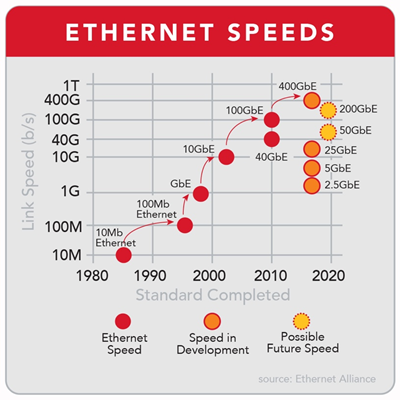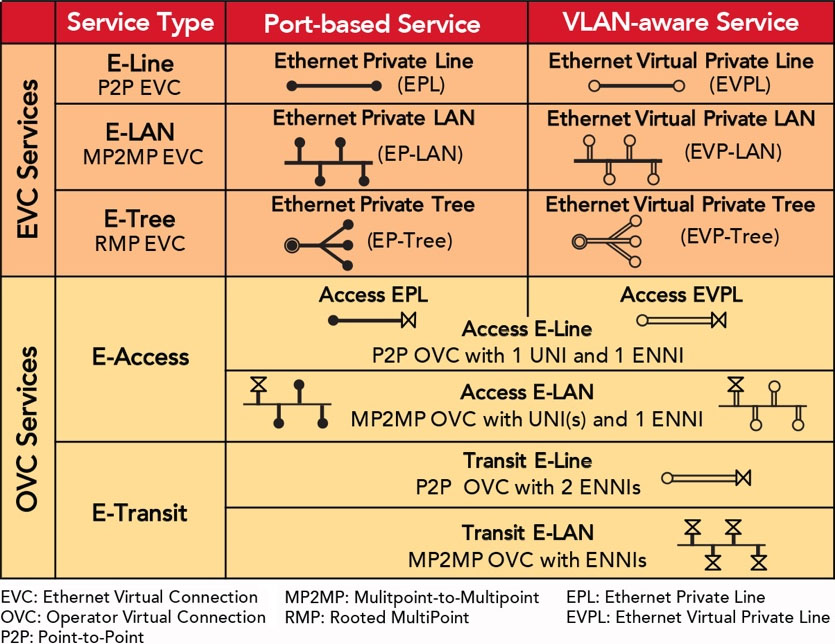Carrier Ethernet 101: Speeds, Standards and Services
For decades, Ethernet has been the technology that runs Local Area Networks (LANs). Those cables snake everywhere through companies and carriers today. With its ubiquity and popularity continuing to drive down the price of components, the economic advantages and market acceptance of Ethernet will likely continue for some time.
Carrier Ethernet (CE) builds on all the advantages of Ethernet by providing a flexible framework, universal frame format, simple design, and enhanced Operations, Administration, and Maintenance (OAM) capabilities for high-performance networks ideally suited for both enterprises and carriers. And like Ethernet, the growing adoption of Carrier Ethernet is changing how networks are built.
In fact, innovation with Carrier Ethernet is moving at an impressive pace. Between the various industry groups and standards bodies, as well as multiple concurrent standards efforts, it’s often hard to keep up. To make sense of it all, in this post I’ll give you an overview of the speeds, standards and services associated with Carrier Ethernet. So, here we go.
Let’s look at Carrier Ethernet speeds
 This chart from the Ethernet Alliance illustrates the growth in Ethernet speeds as defined by the Institute of Electrical and Electronics Engineers (IEEE) from the mid-‘80s and into the future. It’s quite a growth path, isn’t it?
This chart from the Ethernet Alliance illustrates the growth in Ethernet speeds as defined by the Institute of Electrical and Electronics Engineers (IEEE) from the mid-‘80s and into the future. It’s quite a growth path, isn’t it?
The leap to Gigabit Ethernet (and it was a LEAP!) is a fond memory of a quaint time before the turn of the century. 400Gb/s Ethernet is nearly here and there appears to be no end in sight to further speed enhancements.
In fact, history shows that Ethernet bit rates grow tenfold each time a new rate is defined. Gigabit Ethernet (GbE) interfaces are widely deployed in PCs and servers, and 10 Gb/s is quickly becoming the standard for LAN backbones. Don’t look now, but 100Gb/s services aren’t far behind.
But there is a new trend in the evolution of Ethernet where new data rates are envisioned that support specific applications, instead of the habitual 10x rate leap we’ve seen in the past. The 2.5Gb/s rate, for instance, is envisioned specifically to address connecting WiFi access points capable of more than 1Gb/s but nowhere near 10Gb/s. Since cost is of paramount concern in this environment, this rate makes a lot of sense for enterprises and real-estate tenants/landlords. Similarly 5Gb/s and 25Gb/s find specific applications in the data center environment. Interestingly, the Ethernet Alliance chart does not show the next logical 10x rate (1Tb/s) given some technical challenges that will probably push it out beyond the chart’s time horizon, but rest assured, with bit rates in the hundreds of Gb/s and extensions to the standard continuously under development the increasing Ethernet speeds won’t abate any time soon.
Ethernet Service Types
Alongside the work of the IEEE the MEF has been advancing the definition of Carrier Ethernet services since 2001. The early definitions (think E-Line, E-LAN, E-Tree) are now ubiquitous in most service provider service menus. A bit later, wholesale services E-Access and E-Transit were introduced to allow service providers to stitch together end-to-end services using multi-operator networks. Looking to the future, MEF has introduced it’s Lifecycle Services Orchestration framework to allow a myriad of connectivity services in addition to Ethernet proper (think IP, optical, L4+) and value added services (think Security) on top of those. Again, the innovations won’t abate any time soon.

How about CE standards?
|
Demystifying Ethernet Acronyms To help you understand the Ethernet alphabet-soup, I’ve put together a list of some common acronyms that underpin Ethernet services, followed by an explanation of Ethernet service types. CE: Carrier Ethernet Take a look at Ciena’s comprehensive acronym guide here. |
CE has many standards and terms defined by the MEF as a set of building blocks that are then used to assemble a variety of CE services. By using these building blocks, service providers can construct a rich set of CE services that can be understood by buyers and sellers alike using consistent and standardized nomenclature.
Operations, Administration, and Maintenance (OAM) functionality is a hallmark of the legacy TDM-based services that CE has increasingly replaced in the modern network. As a result, Ethernet OAM is required to match those capabilities to provide visibility and assurance to the correct function and services performance. These are critical for delivering on the service management attribute of CE. This is especially important because Ethernet services traversing the WAN can span hundreds to thousands of kilometers.
A rich OAM toolkit has recently been added to the Ethernet protocol standards to allow for OAM functions that provide fault and performance management tools, which were not part of the original LAN technology. I’ve outlined several important new OAM functions in this chart.
| OAM standard | Body | What the Standard Does |
|---|---|---|
| 802.1ag Connectivity Fault Management | IEEE |
Specifies continuity check, loopback and link trace protocols to detect, locate, and isolate network faults. |
| Y.1731 OAM Functions and Mechanisms for Ethernet-based Networks | ITU-T | Supports virtually identical fault management functions as 802.1ag, but adds tools for performance monitoring including Frame Loss Ratio (FLR), Frame Delay (often called latency), and Frame Delay Variation (FDV) (often called jitter). |
| 802.1ah Ethernet in the First Mile | IEEE | Defines mechanisms for monitoring and troubleshooting Ethernet access links. |
| RFC 2544/ Y.1564 Ethernet Service Activation Test Methodology | IETF/ITU-T | Both standards define Ethernet-specific test methodologies to provide verification of key service attributes at the time service is set up (often called a service ‘birth certificate’). |
| RFCs 4379, 6371, 6428 (and others) Label Switched Path (LSP) Ping/TR, + OAM Framework for MPLS-based Transport | IETF | This series of RFCs creates MPLS-specific OAM functions to verify connectivity at the MPLS level (such as detecting and isolating path failures or label mismatches). |
| RFC 5357 Two-Way Active Measurement Protocol (TWAMP) | IETF | Enables two-way performance measurements with TCP/IP and a more accurate time-stamping technique than is available with conventional Ping/Traceroute functions. |
| IEEE 802.1AB Link Layer Discovery Protocol (LLDP) | IEEE | Performs functions to discover the identity and capabilities of network devices in an Ethernet network. |
What to watch
There are a few other areas to watch in the Ethernet realm over the next few years, including:
- Precise Timing Distribution: Beginning with the transition from 2G to 3G mobile networks, CE became a viable and increasingly popular approach for connecting cell towers to mobile telephone switching offices. Earlier backhaul technologies such as SONET/SDH provided both connectivity and precise timing references to the base stations, which in turn used the information to synchronize key functions such as call handoffs between towers and spectrum coordination between calls. As backhaul moved to Ethernet, the synchronization information had to be distributed by other means. GPS was often used but can be problematic and costly in some environments. Synchronous Ethernet, or SyncE, along with ITU-T 1588v2 technology now delivers the same capability over the Ethernet network itself.
- Power over Ethernet: Using an Ethernet cable to provide power to peripheral devices like printers and scanners originated in consumer products. Fairly quickly, enterprises and carriers started using it in their networks as well. Because power and data are carried in the same cable, there’s no need for the expense of a dedicated power source for cameras, wireless radios, and similar devices. IEEE 802.3at, commonly known as PoE+, provides for up to 25 watts of power at distances up to 100 meters.
- FlexEthernet (FlexE): A new approach to matching the speed of the Ethernet physical media to available/existing long-haul optical interfaces. This new approach (similar to today’s Link Aggregation approach, but with less overhead and complexity) will enable cost reductions in routers and other long-haul devices that need to better align the speeds of their interface hardware to the available capacity of the links that interconnect them, without necessarily waiting for a new standard to be finalized.
- Software-Defined Networks (SDN) and Network Functions Virtualization (NFV): The advent of SDN has created new opportunities to rethink the way networks are operated, especially in data center contexts. Network operators have proposed new centralized control mechanisms to more efficiently and cost-effectively run their networks. With NFV, formerly ‘appliance’-based applications (such as routers, firewalls, and load balancers) can be implemented in software (or ‘virtually’) and deployed in a data center. This obviously saves the costs associated with hardware, deployment and ongoing maintenance. Both enterprises and carriers are poised to use SDN and NFV to not only save money, but also innovate at an unprecedented level in the near future.
So the Ethernet journey continues. Carrier Ethernet will continue to play an important role as a flexible, scalable extension of the LAN. The next few years should bring exciting developments as the speeds, standards and services evolve alongside the needs of enterprises and service providers. Watch this space.






